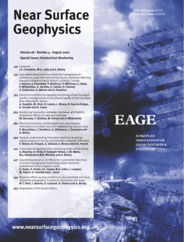-
oa Quantifying seasonal 3D effects for a permanent electrical resistivity tomography monitoring system along the embankment of an irrigation canal
- Source: Near Surface Geophysics, Volume 18, Issue Geoelectrical Monitoring, Jul 2020, p. 427 - 443
-
- 13 Jan 2020
- 06 Jun 2020
- 28 Jun 2020
Abstract
In this paper, we discuss the necessity of quantifying and correcting seasonal 3D effects on 2D electrical resistivity tomography (ERT) data measured along the embankments of rivers or artificial canals. A permanent ERT monitoring system has been continuously operating along the levee of an irrigation canal in Mantua province, Italy, since September 2015. To evaluate the importance of 3D effects and their dependence on seasonal variations, we first performed numerical simulations and also laboratory tests on downscaled levees of the study site. The results showed that 2D apparent resistivity pseudosections measured along the levee are significantly affected by 3D effects of the embankment geometry. Moreover, it was observed that 3D effects not only depend on the levee geometry, but they are also affected by seasonal fluctuations in the water level in the canal. This proved the importance of calculating 3D effects for the study site during dry and irrigation periods. Therefore, different synthetic models based on the levee geometry and water level in the canal in each period were constructed in RES2DMOD and RES3DMODx64 to quantify 3D effects for the study site. The ratios of apparent resistivity values calculated in RES3DMODx64 to the values calculated in RES2DMOD showed that 3D effects approach a maximum of 30% when the canal is empty during winter, and they arrive at a maximum of 10% when the canal is filled with water in summer. Using the graphs of the modelled 3D effects as a function of electrode spacing, apparent resistivity pseudosections measured by the permanent ERT system are corrected for 3D effects to obtain reliable resistivity sections after inversion. The final resistivity maps can be then converted into water content images using the empirical and site‐dependent relationship developed from core samples in the study area. Water content maps can be used to evaluate the stability of the levee and to detect possible seepage zones.




